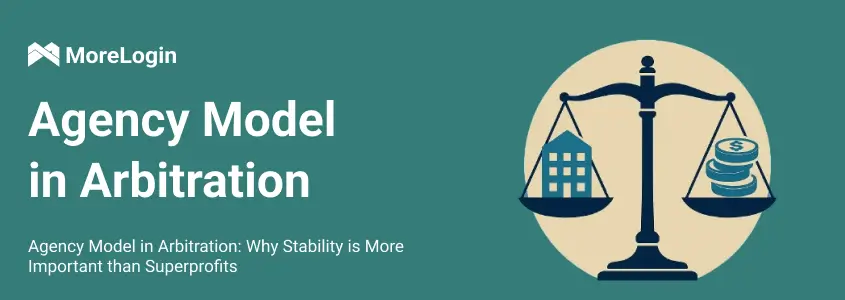
- Product

- Pricing
- Affiliate Program
- Use Cases
- Resource


Agency Model in Arbitration: Why Stability Is More Important Than Superprofits
In the world of arbitration, the logic of “maximum ROI and high CPA payouts equals success” is still popular. But the reality has changed. Many teams are consciously moving away from explosive numbers in favor of stable, predictable income. Today, let’s talk about the agency (or spend-based) model: how it works, why it benefits everyone involved, and why “less on paper” isn’t always worse.
The agency model implies that an arbitration team operates like a mini-agency. It receives a fixed percentage of the advertising budget, typically ranging from 30–40%. This means the compensation is calculated not from the advertiser's profit, but from the amount they are willing to invest in traffic acquisition.
Unlike the CPA model, where everything revolves around ROI and testing, this model is about a systematic approach: long-term relationships, clear KPIs, and a transparent financial structure. Media buyers operate within a predictable ecosystem, free from endless “cuts,” “holds,” and “paused offers.”
Work is built on trust and strategic partnership. Instead of constantly chasing new bundles and worrying that an offer will “die” in a week, the team establishes a stable process. This enables budget planning, internal resource development, hypothesis testing—without pressure or burnout. Buyers focus not on short-term gains, but on traffic quality, product understanding, and the user funnel. The team, in turn, gets access to priority offers and GEOs, regularly syncs with the advertiser on metrics, and can even influence the product funnel by suggesting improvements.
The team knows exactly how much it will earn each month. They can structure work cycles, plan budgets, hire staff—without the fear that they’ll have to rebuild everything next week because “the creative died” or “the offer was pulled.”
Yes, the ROI might look more modest on paper. But in practice, the team drives far higher volumes, scales efficiently, and maintains a stable cash flow.
One word: transparency.
The advertiser doesn’t get junk traffic, doesn’t have to waste resources filtering fraud, and doesn’t worry about a dozen partners pushing inconsistent traffic. They work with a team that’s invested in long-term cooperation and clearly understands which metrics matter.
At the same time, they know upfront:
How much they’ll spend;
What results to expect (e.g., CPI, ARPU, Retention);
What will happen if the results are better or worse than expected.
This approach replaces dozens of unstable CPA partners with one reliable traffic supplier who has a business mindset.
At first glance, a fixed 30–40% of the budget might seem low. But don’t forget: under the CPA model, you can hit high ROI—but there’s no promise of consistency.
The agency model allows you to scale steadily and avoid cash flow gaps. You won’t get 100% ROI from one offer—but you can consistently manage tens or hundreds of thousands of dollars in budget each month.
Top teams report driving 500–600K installs per month. That’s hundreds of thousands in traffic spend, from which the team reliably earns its share. And at those volumes, ad account commissions can drop to 3–4%, making the economics even more attractive.
A CPA arbitrageur lives in constant uncertainty. How much will they spend? What will they get back? Will they even be paid? It’s a constant race, emotional burnout, and creative chaos.
The agency model? Completely different. Buyers have a clear rate—they know what they’re earning today and tomorrow, independent of offer mood swings or payment delays. It changes the very nature of the work—they can focus on quality and sustainable growth instead of survival.
Instead of chaotic daily tests and hunting for the next offer, a buyer builds a predictable funnel where each action leads to results. Work becomes calmer but more effective—traffic flows steadily, KPIs are met, and efficiency grows through accumulated expertise. Many teams stick to just a few GEOs, refine their strategies, and improve conversion at every funnel stage—without being distracted by constant changes. This allows the team to grow their internal expertise and achieve high earnings without the stress of chasing the “next goldmine offer.”
For the spend-based model to truly work, traffic must be high-quality. That means not just driving flow, but building a conversion-optimized funnel tailored to a specific GEO and audience.
What matters:
Creatives – Native, locally flavored, ideally with UGC elements;
PWA – Visually engaging, with interactive interfaces and gamification;
Landing page – A logical extension of the creative, not a separate entity.
It’s better to have 7 engaged users than 15 random ones. The key is for every element to be part of a unified story—where banner, landing page, and product work as one. In this process, tech plays a crucial role: multi-account management, anti-detection systems, and a clean launch environment.
That’s why tools like MoreLogin anti-detect browser help buyers reduce ban risks, improve account stability, and maintain traffic quality at scale. MoreLogin safely manages multiple profiles without overlaps or data leaks by spoofing fingerprints and emulating real user behavior. This makes campaigns more predictable and effective—ensuring every step in the funnel leads to real results.
The agency model is about stability, transparency, and well-defined processes, where each party gets exactly what they need. The team knows their income and can grow without constant stress. The advertiser gets predictable results and quality traffic. And buyers work without burnout or daily risks.
This model doesn’t win through flashy numbers—but through structure and sustainability. That’s what makes it the future of arbitration.